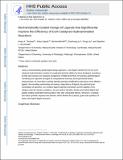Mechanistically Guided Design of Ligands That Significantly Improve the Efficiency of CuH-Catalyzed Hydroamination Reactions
Author(s)
Thomas, Andy; Speck, Klaus; Kevlishvili, Ilia; Lu, Zhaohong; Liu, Peng; Buchwald, Stephen Leffler; ... Show more Show less
DownloadAccepted version (903.2Kb)
Terms of use
Metadata
Show full item recordAbstract
Using a mechanically guided ligand design approach, a new ligand (SEGFAST) for the CuH-catalyzed hydroamination reaction of unactivated terminal olefins has been developed, providing a 62-fold rate increase over reactions compared to DTBM-SEGPHOS, the previous optimal ligand. Combining the respective strengths of computational chemistry and experimental kinetic measurements, we were able to quickly identify potential modifications that lead to more effective ligands, thus avoiding synthesizing and testing a large library of ligands. By optimizing the combination of attractive, noncovalent ligand-substrate interactions and the stability of the catalyst under the reaction conditions, we were able to identify a finely tuned hybrid ligand that greatly enables accelerated hydrocupration rates with unactivated alkenes. Moreover, a modular and robust synthetic sequence was devised, which allowed for the practical, gram-scale synthesis of these novel hybrid ligand structures.
Date issued
2018-09Department
Massachusetts Institute of Technology. Department of ChemistryJournal
Journal of the American Chemical Society
Publisher
American Chemical Society (ACS)
Citation
Thomas, Andy, et al. "Mechanistically Guided Design of Ligands That Significantly Improve the Efficiency of CuH-Catalyzed Hydroamination Reactions." Journal of the American Chemical Society 140, 42 (Sept. 2018): p. 13976-84 doi 10.1021/JACS.8B09565 ©2018 Author(s)
Version: Author's final manuscript
ISSN
1520-5126